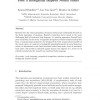21 search results - page 4 / 5 » Discriminating Animate from Inanimate Visual Stimuli |
JOCN
2010
13 years 18 days ago
2010
The human brain contains cortical areas specialized in representing object categories. Visual experience is known to change the responses in these category-selective areas of the ...
IJON
2000
13 years 5 months ago
2000
Synchronized neuronal ring has been reported in many neural systems and may play a role in the representation of sensory stimuli and the modi cation of sensory representations by ...
NN
2008
Springer
13 years 5 months ago
2008
Springer
Research into the visual perception of human emotion has traditionally focused on the facial expression of emotions. Recently researchers have turned to the more challenging field...
IJCAI
2007
13 years 7 months ago
2007
Over the past decade functional Magnetic Resonance Imaging (fMRI) has emerged as a powerful technique to locate activity of human brain while engaged in a particular task or cogni...
NIPS
2001
13 years 7 months ago
2001
In nature, animals encounter high dimensional sensory stimuli that have complex statistical and dynamical structure. Attempts to study the neural coding of these natural signals f...

